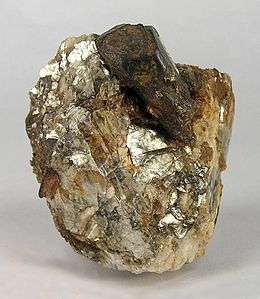Columbite
Columbite, also called niobite, niobite-tantalite and columbate [(Fe,Mn)Nb
2O
6], is a black mineral group that is an ore of niobium. It has a submetallic luster and a high density and is a niobate of iron and manganese. This mineral group was first found in Haddam, Connecticut, in the United States. It forms a series with the tantalum-dominant analogue ferrotantalite and one with the manganese-dominant analogue manganocolumbite. The iron-rich member of the columbite group is ferrocolumbite. Some tin and tungsten may be present in the mineral. Yttrocolumbite is the yttrium-rich columbite with the formula (Y,U,Fe)(Nb,Ta)O
4. It is a radioactive mineral found in Mozambique.
| Columbite | |
|---|---|
 | |
| General | |
| Category | Oxide minerals |
| Formula (repeating unit) | Fe2+ Nb 2O 6 |
| Strunz classification | 4.DB.35 |
| Crystal system | Orthorhombic |
| Crystal class | Dipyramidal (mmm) H-M symbol: (2/m 2/m 2/m) |
| Space group | Pbcn |
| Identification | |
| Color | Black, brownish black. |
| Crystal habit | Massive - Granular - Common texture observed in granite and other igneous rock; Striated - Parallel lines on crystal surface or cleavage face. |
| Cleavage | [010] Distinct |
| Fracture | Sub Conchoidal: Fractures developed in brittle materials characterized by semi-curving surfaces. |
| Mohs scale hardness | 6 |
| Luster | sub-metallic |
| Streak | blackish brown |
| Specific gravity | 5.3–7.3, Average = 6.3 |
| Optical properties | Biaxial (+), b=2.29–2.4 |
| Other characteristics | non-radioactive, non-fluorescent. |
| References | [1][2][3] |
Columbite has the same composition and crystal symmetry (orthorhombic) as tantalite. In fact, the two are often grouped together as a semi-singular mineral series called columbite-tantalite or coltan in many mineral guides. However, tantalite has a much greater specific gravity than columbite, more than 8.0 compared to columbite's 5.2.[4]
Columbite is also very similar to tapiolite. Those minerals have same chemical composition but different crystal symmetry: orthorhombic for columbite and tetragonal for tapiolite.[5] The largest documented single crystal of columbite consisted of plates 6 mm (0.24 in) thick measuring 76 cm × 61 cm (30 in × 24 in).[6]
History and etymology
The occurrence of columbite in the United States was made known from a specimen presumably stemming from John Winthrop (1606–1676), first Governor of the Connecticut Colony and avid mineral collector. Amidst 600 other samples, it was donated by his namesake and grandson, John Winthrop (1681–1747) to Hans Sloane, President of the Royal Society of London, upon becoming a Fellow of the Royal Society in 1737.[7]
In 1801 Charles Hatchett discovered the element niobium in this specimen,[8] which he named columbium in honour of explorer Christopher Columbus.[9]
See also
References
- Mineralienatlas
- Columbite-(Fe) Mineral Data
- Columbite-(Fe) on Mindat.org
- mindat.org Tantalite
- P. Cerny et al. "The tantalite-tapiolite gap: natural assemblages versus experimental data" Canadian Mineralogist 30 (1992) 587 free download
- P. C. Rickwood (1981). "The largest crystals" (PDF). American Mineralogist. 66: 885–907.
-
Winthrop, John (1844). Silliman, Benjamin (ed.). "Art. V. Selections from an Ancient Catalogue of objects of Natural History, formed in New England more than one hundred years ago". The Amer. J. Science and Arts 47. New Haven: Baldwin, Cradock, and Joy. p. 282. Retrieved 12 February 2015.
... (p.282:) Mr. Winthrop was grandson of the first governor of Connecticut, great grandson of the first governor of Massachusetts ... (p.290:) A black mineral ... Is this the Columbite? ... it appeared that it had been sent ... to Sir Hans Sloane, by Mr. Winthrop of Massachusetts. ...'
-
Griffith, William P.; Morris, Peter J.T. (22 September 2003). "Charles Hatchett FRS (1765–1847), Chemist and Discoverer of Niobium" (PDF). The Annals of Philosophy. New Series. July to December 1824. London: The Royal Society Publishing. p. 359. Retrieved 12 February 2015.
... In 1800–01, while he was arranging some minerals at the British Museum in Bloomsbury, he became particularly interested in a specimen which was described in Sir Hans Sloane’s catalogue of the ‘Metalls’, no. 2029 from his collection, as ‘a very heavy black stone with golden streaks ... from Nautneague. From Mr. Winthrop’ ... The donor was probably John Winthrop (1681–1747), a great-grandson of the founder of Massachusetts Bay colony. When Winthrop was elected FRS in 1734 he gave Sir Hans Sloane, then President of the Society, a collection of about 600 minerals. ...'
-
Jameson, Robert (1805). System of Mineralogy, Vol. II. Edinburgh: Bell and Bradfute (et al.). p. 582. Retrieved 15 February 2015.
... Mr Hatchett found it to contain a metal, which, from its properties, could not be referred to any hitherto known; hence he was of opinion that it should be considered as a new genus, to which he gave the name Columbium, in honour of the discoverer of America. ...'
External links
| Wikimedia Commons has media related to Columbite. |

- "Columbite". New International Encyclopedia. 1905.
- "Columbite". Encyclopædia Britannica (11th ed.). 1911.
- . Collier's New Encyclopedia. 1921.